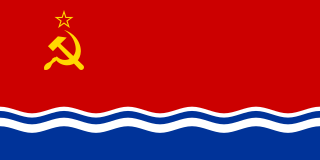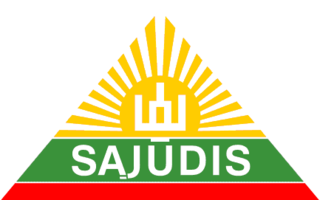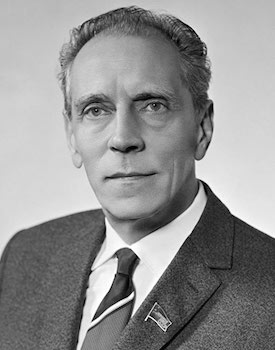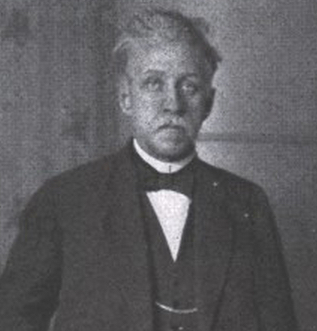
The Singing Revolution was a series of events from 1987 to 1991 that led to the restoration of independence of the three Soviet-occupied Baltic countries of Estonia, Latvia, and Lithuania at the end of the Cold War. The term was coined by an Estonian activist and artist, Heinz Valk, in an article published a week after the 10–11 June 1988 spontaneous mass evening singing demonstrations at the Tallinn Song Festival Grounds.

The Latvian Soviet Socialist Republic, also known as Soviet Latvia or simply Latvia, was de facto one of the constituent republics of the Soviet Union between 1940–1941 and 1944–1990.

Guntis Ulmanis is a Latvian politician and the fifth President of Latvia from 1993 to 1999.

The Workers' Socialist Federation was a socialist political party in the United Kingdom, led by Sylvia Pankhurst. Under many different names, it gradually broadened its politics from a focus on women's suffrage to eventually become a left communist grouping.

Boris Karlovich Pugo was a Soviet communist politician of Latvian origin.
The CTAG Helsinki-86 was founded on 10 July 1986 in the Latvian port town of Liepāja by three workers: Linards Grantiņš, Raimonds Bitenieks, and Mārtiņš Bariss. Its name refers to the Helsinki Accords and the year of its founding.

Captain 3rd Rank Valery Mikhailovich Sablin was a Soviet Navy officer and a member of the Communist Party. In November 1975, he noticed the rampant corruption and stagnation in Leonid Brezhnev's Soviet Union, he then led a mutiny on the Soviet anti-submarine frigate, Storozhevoy in the hope of starting a Leninist political revolution in the Soviet Union. His mutiny failed and he was executed for treason nine months later.

Sąjūdis, initially known as the Reform Movement of Lithuania, is a political organisation which led the struggle for Lithuanian independence in the late 1980s and early 1990s. It was established on 3 June 1988 as the first opposition party in Soviet Lithuania, and was led by Vytautas Landsbergis. Its goal was to seek the return of independent status for Lithuania.

Arvīds Pelše was a Latvian Soviet politician, functionary, and historian.

Pēteris Stučka, sometimes spelt Pyotr Stuchka;, was a Latvian jurist and communist politician, leader of the pro-Bolshevik puppet government in Latvia during the 1918–1920 Latvian War of Independence, and later a statesman in the Soviet Union.

The Revolutions of 1989, also known as the Fall of Communism, were a revolutionary wave of liberal democracy movements that resulted in the collapse of most Marxist–Leninist governments in the Eastern Bloc and other parts of the world. This revolutionary wave is sometimes referred to as the Autumn of Nations, a play on the term Spring of Nations that is sometimes used to describe the Revolutions of 1848 in Europe. The Revolutions of 1989 contributed to the dissolution of the Soviet Union—one of the two global superpowers—and the abandonment of communist regimes in many parts of the world, some of which were violently overthrown. These events drastically altered the world's balance of power, marking the end of the Cold War and the beginning of the post-Cold War era.

The Union of Soviet Socialist Republics (USSR) was formally dissolved as a sovereign state and subject of international law on 26 December 1991 by Declaration № 142-Н of the Soviet of the Republics of the Supreme Soviet of the Soviet Union. It also brought an end to the Soviet Union's federal government and General Secretary Mikhail Gorbachev's effort to reform the Soviet political and economic system in an attempt to stop a period of political stalemate and economic backslide. The Soviet Union had experienced internal stagnation and ethnic separatism. Although highly centralized until its final years, the country was made up of 15 top-level republics that served as the homelands for different ethnicities. By late 1991, amid a catastrophic political crisis, with several republics already departing the Union and Gorbachev continuing the waning of centralized power, the leaders of three of its founding members, the Russian, Belorussian, and Ukrainian SSRs, declared that the Soviet Union no longer existed. Eight more republics joined their declaration shortly thereafter. Gorbachev resigned on 25 December 1991 and what was left of the Soviet parliament voted to dissolve the union.

The General Jewish Labour Bund in Lithuania, Poland and Russia, generally called The Bund or the Jewish Labour Bund, was a secular Jewish socialist party initially formed in the Russian Empire and active between 1897 and 1920. In 1917, the Bund organizations in Poland seceded from the Russian Bund and created a new Polish General Jewish Labour Bund which continued to operate in Poland in the years between the two world wars. The majority faction of the Russian Bund was dissolved in 1921 and incorporated into the Communist Party. Other remnants of the Bund endured in various countries. A member of the Bund was called a Bundist.

Yuri Petrovich Gaven, born Jānis Daumanis, was a Latvian revolutionary and Soviet politician and Chekist. He was a key figure in the defeat of the Crimean People's Republic and the establishment of the short-lived Taurida Soviet Socialist Republic and an active participant in the Red Terror in Crimea. Executed during the Stalinist purges in 1936, he was rehabilitated in 1958.

October Revolution Day was a public holiday in the Soviet Union and other Soviet-aligned states, officially observed on November 7 from 1927 to 1990, commemorating the 1917 October Revolution.
The following lists events that happened during 1990 in the Union of Soviet Socialist Republics.
The 1957 October Revolution Parade was a parade on Moscow's Red Square dedicated to the ruby jubilee of the Great October Socialist Revolution on 7 November 1957.
The 1976 October Revolution Parade was a parade on Moscow's Red Square on November 7, 1976, dedicated to the 59th anniversary of the October Revolution. The parade marked the last appearance of Politburo member Nikolai Podgorny. Newly appointed Soviet Defense Minister Dmitry Ustinov greeted armed battalions while the parade was commanded by Moscow Military District, Colonel General Vladimir Govorov. Nikolay Mikhaylov conducted the Combined Orchestra of the Moscow Garrison which provided the music for the parade. General Secretary of the Communist Party of the Soviet Union Leonid Brezhnev and other high-ranking officials within the Communist Party of the Soviet Union spectated the parade from the grandstand of Lenin's Mausoleum. Although military vehicles were present, there was no display of tanks.

Pranas Eidukevičius was a Lithuanian socialist activist and communist revolutionary. He was a member of the central committee of the Social Democratic Party of Lithuania in 1906–1918 and chairman of the short-lived Communist Party of Lithuania and Belorussia (1918) and Vilna Soviet of Workers Deputies (1918–1919).
Jānis Vagris was a Latvian politician. He served as the sixth Chairman of the Presidium of the Supreme Soviet of the Latvian Soviet Socialist Republic from 1985 to 1988, and as Secretary of the Central Committee of the Communist Party of Latvia from 1988 to 1990.















